I’ve long been interested in drought-tolerant, low-maintenance perennial species. They are ideal for landscaping and naturalizing, creating attractive, multi-functional (with proper species choice) ornamental gardens.
Drought tolerance in perennials varies significantly. Some species prefer or require moist or even wet soil. Others can thrive in very dry soil.
In my own yard, I completely stopped watering over 6 years ago, to brutally test drought tolerance of my favorite species in the clay soil on site. And the past two summers, I have had the chance to evaluate farms and gardens around Bear Lake, MI. Northwest Michigan is predominated by extremely sandy soil, and the last two summers have been very dry.
By using at least moderately drought tolerant species in landscaping and farm or garden plantings, the overall need for supplemental irrigation can be reduced once plants are well-established. Of course, with any amount of annual rainfall and irrigation, a dry, sandy or gravely soil low in organic matter will be more dry than a soil higher in clay or organic matter. Mulching with organic material can help reduce loss of water from the soil.
Siting and microclimates can also affect drought tolerance. Extremely hot, sunny sites can increase moisture loss from plants and soils, particularly when soil is not mulched. A partly shaded location may help improve the drought tolerance of species that normally prefer full sun, particularly when grown in sandy soil.
Remember that any given drought tolerance rating applies to established plants. It may take a full season of growth for new plants to become fully established in a new site. Even drought tolerant plants benefit from supplemental irrigation for the first few weeks or months after transplant.
Plants respond in different ways to drought conditions. The least drought tolerant species die in when soils are too dry. More tolerant species will grow and flower well, without significant problems from drought. Sedum, for example, is generally extremely drought tolerant. Less tolerant species may exhibit leaf necrosis (browning and death), smaller than normal flowers, a reduced flowering window, or a complete lack of flowering in drought conditions. Some species tend to be more short-lived under very dry conditions, as well.
Succulent species have fleshy, water-storing leaves which generally improves their drought tolerance. Succulent species include Delosperma (ice plant), Sedum (stonecrop), and Sempervivum (hens and chicks).
In terms of drought tolerance, I generally group the drought tolerance of a perennial species as: average, moderate, or extreme. Like all human created labels for living creatures, drought tolerance is more of a spectrum than a set of clearly defined boxes. The other end of the drought tolerance spectrum are moisture preferring species, those that prefer or require moist to wet soils. There are also some species that will persist in dry sites, but not thrive. Typically, they grow little and do not flower strongly, if at all, without supplemental irrigation. I consider these species to be “drought persistent.”
Extremely drought tolerant perennials are the most drought tolerant species. Many prefer or require well-drained soil. Once established, they can survive with little to no supplemental irrigation, even in prolonged periods of drought.
Moderately drought tolerant perennials can survive for several years during drought without irrigation. They benefit from an occasional watering by being longer lived and more floriferous.
Perennials which have average drought tolerance can survive limited drought, but require supplemental irrigation for best performance.
Drought Persistent species will persist, but not thrive in dry soils. Flowering typically limited to absent. Examples of drought persistant species include: Iris species, Paeonia species (peony), and Hemerocallis (day lily).
Spring blooming bulbs and ephemerals can also be good choices for areas with dry summers, but wetter springs. Suggested species include daffodill (Narcissus species), squill (Scillia and Puschkinia spp.)
Below is information on my favorite extremely drought tolerant perennials. These species are ideal for good performance in tough, dry sites with minimal irrigation (once established). All are hardy to at least zone 5.
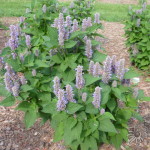 Agastache foeniculum – anise hyssop. A great, multi-use species. Fragrant foliage that smells of anise and is excellent for making herbal teas or used in potpourri. A very good nectar plant for honey bees and an attractive ornamental.
Agastache foeniculum – anise hyssop. A great, multi-use species. Fragrant foliage that smells of anise and is excellent for making herbal teas or used in potpourri. A very good nectar plant for honey bees and an attractive ornamental.
There are a number of other species, and hybrids, on the market.
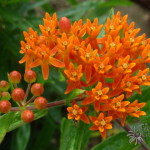 Asclepias tuberosa – butterfly weed. An absolutely lovely native which is strongly butterfly attractive, and is a larval food plant for monarch butterfly. Flowers are typically in orange shades, but can include yellows, bicolor red and orange, and red. Dried seed pods are attractive in dry arrangements. Requires well-drained soil, and generally dislikes clay soil (though Prairie Nursery has a selection that grows well in soils.
Asclepias tuberosa – butterfly weed. An absolutely lovely native which is strongly butterfly attractive, and is a larval food plant for monarch butterfly. Flowers are typically in orange shades, but can include yellows, bicolor red and orange, and red. Dried seed pods are attractive in dry arrangements. Requires well-drained soil, and generally dislikes clay soil (though Prairie Nursery has a selection that grows well in soils.
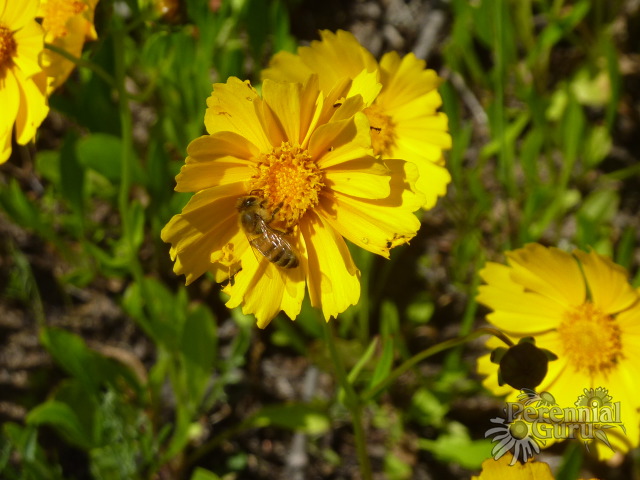 Coreopsis lanceolata – sand coreopsis. A North American native species with ornamental yellow flowers that are very attractive to honey bees, solitary bees, and Syrphid species (hover flies). Note that Coreopsis grandiflora tends to be less drought tolerant than C. lanceolata.
Coreopsis lanceolata – sand coreopsis. A North American native species with ornamental yellow flowers that are very attractive to honey bees, solitary bees, and Syrphid species (hover flies). Note that Coreopsis grandiflora tends to be less drought tolerant than C. lanceolata.
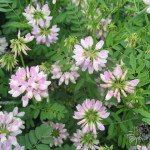 Coronilla varia – crown vetch. An ornamental, creeping groundcover with attractive pink and white flowers. Note that this species does not tolerate mowing. A good beneficial insect attractor. Also fixes nitrogen. An excellent, low-maintenance species.
Coronilla varia – crown vetch. An ornamental, creeping groundcover with attractive pink and white flowers. Note that this species does not tolerate mowing. A good beneficial insect attractor. Also fixes nitrogen. An excellent, low-maintenance species.
Erianthus ravennae – hardy pampas grass. A robust, tall ornamental grass, somewhat similar in effect to pampas grass (Cortaderia species) but hardy.
Festca species – Fescues. Fescues are ornamental grasses typically with blueish to blue-green foliage and clump-forming habits. Includes some North American native species.
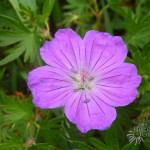 Geranium sanguineum – bloody cranesbill. A groundcover with attractive, magenta flowers. One of the species that flowered well in early summer at Two Fish Farms. Despite neglect in a very sandy soil, plants have spread well from initial plantings. The flowers are ornamental, but not particularly attractive to beneficial insects.
Geranium sanguineum – bloody cranesbill. A groundcover with attractive, magenta flowers. One of the species that flowered well in early summer at Two Fish Farms. Despite neglect in a very sandy soil, plants have spread well from initial plantings. The flowers are ornamental, but not particularly attractive to beneficial insects.
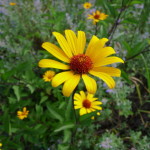 Heliopsis helianthoides – oxe eye daisy. An excellent, long-blooming species that is attractive to pollinators and beneficial insects. ‘Summer Sun’ is a standard, seed propagated cultivar with golden yellow blooms. Heliopsis helianthoides var. scabra ‘Summer Nights’ has attractive purple stems that contrast interestingly with the flowers.
Heliopsis helianthoides – oxe eye daisy. An excellent, long-blooming species that is attractive to pollinators and beneficial insects. ‘Summer Sun’ is a standard, seed propagated cultivar with golden yellow blooms. Heliopsis helianthoides var. scabra ‘Summer Nights’ has attractive purple stems that contrast interestingly with the flowers.
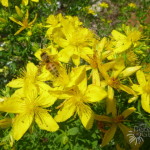 Hypericum perfoliatum – St. John’s wort. A European native with attractive, yellow flowers are very highly visited by bumblebees and are also somewhat attractive to other pollinators including honey bees and solitary bees.
Hypericum perfoliatum – St. John’s wort. A European native with attractive, yellow flowers are very highly visited by bumblebees and are also somewhat attractive to other pollinators including honey bees and solitary bees.
Considered a medicinal herb.
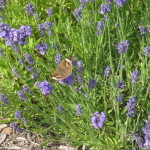 Lavandula angustifolia – English lavender. An excellent culinary and ornamental herb. Fragrant, grey foliage and purple flowers in spikes which are attractive to butterflies. Requires well-drained soil, especially in winter. A number of varieties are available, both seed and vegetative selections. The ‘Ellagance’ series from Kieft Seed is an excellent, first year flowering seed strain available in a range of colors.
Lavandula angustifolia – English lavender. An excellent culinary and ornamental herb. Fragrant, grey foliage and purple flowers in spikes which are attractive to butterflies. Requires well-drained soil, especially in winter. A number of varieties are available, both seed and vegetative selections. The ‘Ellagance’ series from Kieft Seed is an excellent, first year flowering seed strain available in a range of colors.
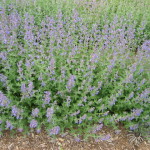 Nepeta species – Catmint. A number of species are excellent, including N. x fassennii and N. racemosa. Very attractive to both solitary bees and honey bees. Plants have strongly fragrant foliage, are typically long-blooming, and don’t require deadheading.
Nepeta species – Catmint. A number of species are excellent, including N. x fassennii and N. racemosa. Very attractive to both solitary bees and honey bees. Plants have strongly fragrant foliage, are typically long-blooming, and don’t require deadheading.
‘Walker’s Low’ is a popular vegetative selection. Note that it is named for a place in the UK, not for its habit. For a lower-growing variety, consider ‘Junior Walker’, a new dwarf selection from Conard-Pyle.
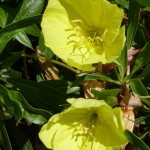 Oenothera macrocarpa (syn. O. missouriensis) – MIssouri primrose. A native North American groundcover with a trailing habit, reddish stems, and large (3 to 4 inch diameter), slightly fragrant, bright yellow flowers. Flowers remain open just a single day before fading. Still commonly listed in the trade under the name Oenothera missouriensis.
Oenothera macrocarpa (syn. O. missouriensis) – MIssouri primrose. A native North American groundcover with a trailing habit, reddish stems, and large (3 to 4 inch diameter), slightly fragrant, bright yellow flowers. Flowers remain open just a single day before fading. Still commonly listed in the trade under the name Oenothera missouriensis.
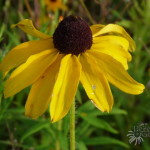 Rudbeckia hirta – black-eyed susan. A native annual to short-lived perennial or biennial, prone to reseeding. Under extreme drought, plants tend to produce smaller and fewer flowers, but survive well. The unimproved species tends to be more drought tolerant than many created varieties, particularly the dwarfer types.
Rudbeckia hirta – black-eyed susan. A native annual to short-lived perennial or biennial, prone to reseeding. Under extreme drought, plants tend to produce smaller and fewer flowers, but survive well. The unimproved species tends to be more drought tolerant than many created varieties, particularly the dwarfer types.
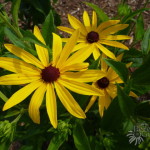 Rudbeckia subtomentosa – sweet coneflower. The most drought tolerant Rudbeckia in my experience, and one of my favorite Rudbeckia species. Large, yellow flowers with prominent brown cones and greyish green leaves with hairy undersides. Flowers are lightly fragrant and make good cuts. Blooms summer to fall. ‘Goldstrum’ in my experience is moderately drought tolerant and shorter-lived under extremely dry conditions.
Rudbeckia subtomentosa – sweet coneflower. The most drought tolerant Rudbeckia in my experience, and one of my favorite Rudbeckia species. Large, yellow flowers with prominent brown cones and greyish green leaves with hairy undersides. Flowers are lightly fragrant and make good cuts. Blooms summer to fall. ‘Goldstrum’ in my experience is moderately drought tolerant and shorter-lived under extremely dry conditions.
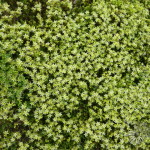 Sedum species – stonecrop. There are a number of different Sedum species, ranging in height from just a few inches to a few feet tall. All are extremely drought tolerant, and many are hardy. Many species are also good pollen and nectar sources for bees and beneficial insects.
Sedum species – stonecrop. There are a number of different Sedum species, ranging in height from just a few inches to a few feet tall. All are extremely drought tolerant, and many are hardy. Many species are also good pollen and nectar sources for bees and beneficial insects.
Fall-blooming types are particularly useful for providing pollinator and beneficial insect habitat.
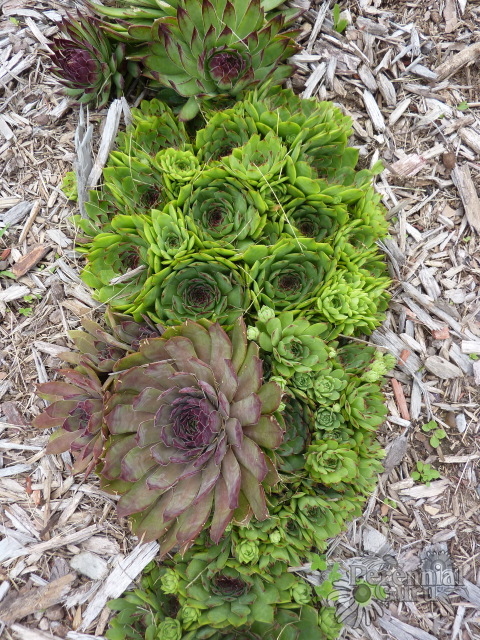 Sempervivum species – hens and chicks. An interesting succulent with fleshy leaves in rosettes. Often represented in the trade by ‘Hardy Species Mix’, a seed mixture of a number of different forms. Some forms have attractive, web-like growths on the rosettes. Very drought tolerant and low-maintenance.
Sempervivum species – hens and chicks. An interesting succulent with fleshy leaves in rosettes. Often represented in the trade by ‘Hardy Species Mix’, a seed mixture of a number of different forms. Some forms have attractive, web-like growths on the rosettes. Very drought tolerant and low-maintenance.
